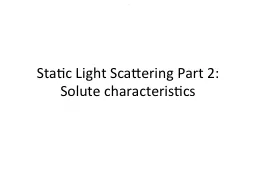

2 S olute characteristics 786 What can light scattering measure Molecular Weight M Radius of gyration R g Second virial coefficient A 2 For a solute in solution light scattering can determine ID: 543115
Download Presentation The PPT/PDF document "Static Light Scattering Part" is the property of its rightful owner. Permission is granted to download and print the materials on this web site for personal, non-commercial use only, and to display it on your personal computer provided you do not modify the materials and that you retain all copyright notices contained in the materials. By downloading content from our website, you accept the terms of this agreement.
Slide1
Static Light Scattering Part 2: Solute characteristics
786Slide2
What can light scattering measure?
Molecular Weight,
M
Radius of gyration, RgSecond virial coefficient, A2
For a solute in solution, light scattering can determine:
A typical application is the determination of the weight average molecular weight
M
of a
macromolecule
... the
radius of gyration
R
g
or the form and structure factor. By measuring the scattering intensity
at
various concentrations, the second
virial
coefficient
A
2
, can be
calculated
. Special analysis techniques such as
the
Zimm
or
Guinier
Plot
can
be used to obtain
results
from the measured data
. –
lsinstruments.chSlide3
Background toluene and solvent also scatter light due to density fluctuationsSlide4
What does I(q) tell us?
Form factor
P
(q)Information about individual particlesStructure factor S(q)Information about “particle packing”Dependent on pair-correlation functionBoth individual solute molecules/particles and their arrangement in solution contribute to ISlide5
Structure Factor S(q)
Pair correlation function depends on
interparticle
interaction
Umax
U
r
U(R)Slide6
Second virial coefficientAlso related to
interparticle
potential
From thermodynamics: Deviation from ideal gas law based on interaction between 2 particles
U(R)Slide7
Pair correlation g(r) and
Structure factor
S
(q)g(r)
S(q)Slide8
Pair correlation
g
(
r) andStructure factor S(q)g(r)
S(q)Slide9
Pair correlation
g
(
r) andStructure factor S(q)g(r)
S(q)Slide10
Understanding SLS dataSLS simultaneously measures
I
,
Kc/R & RH RH is hydrodynamic radius, same as from DLSc is concentration of soluteK is a material constant; n = refractive indexKc/R is called the “Rayleigh Ratio,” where R is the “excess scattering” from the
solute aloneSlide11
Rayleigh RatioThe instrument measures this quantity as a function of angleIt can be derived that:
Where
M
= molecular weight, B2 = second virial coefficientc
From form factor
From structure factorSlide12
Zimm Plot
Simplifications:
w
hen q 0 this becomes linear! M comes form intercept and B2 from slope
c
cSlide13
Zimm PlotMeasure
Kc
/
R for multiple concentrations at multiple anglesPlot tool extrapolates q 0 and c 0 What if you don’t know K and/or c very precisely?
Traces represent different c’s
Kc
/
RSlide14
–
lsinstruments.chSlide15
Zimm
Plot
Extrapolations:
c
c
q
0
c
0
Intercept = 1/M
M = weight-averaged molecular weightSlide16
Note: Form Factor
P
Geometrical Consideration: integral over the particle/molecule volume considering position of each point within the particle/molecule
Also equal to Which is convenient when q and R are known (typically use R from measurement at 90 degrees)Slide17
Form Factor P for a SphereSlide18
Form Factor PGuinier Approximation:
Initial slope gives
radius of gyration
Don’t need to specify c or dn/dc!Slide19
Radius of gyration & shape factorRadius of gyration = mass distribution about the center of massP
=
R
g / RHShape factor for…Sphere = 0.67Ring = 1Slide20
Lab TasksSLS measurement on polymer standardSLS on BSA protein (?)
Use Plot & Fit software to assist with
Zimm
plots and extraction of parameters – thank you Sharon!